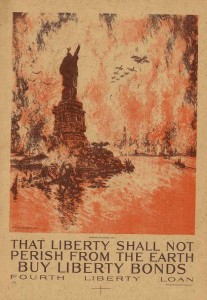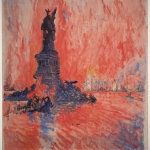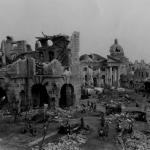Near the end of WWI, the U. S. government issued the Fourth Liberty Loan on September 28, 1918. The Loan was to float government bonds sold in the United States. The monies gathered were used by the U. S. Treasury to support the allied cause in the War. The Treasury needed to raise close to 6 billion dollars through this loan effort.* The Loan would only be open to bond purchasers through October 19th of that same year.
In anticipation of this new Loan campaign, the Pictorial Division of the Committee on Public Information** decided that they would offer a competition among the artists of the United States for poster designs to announce the Loan. Among the illustrators who worked for the Division as an Associate Chairmen was Joseph Pennell, the Philadelphia born artist and illustrator who with his wife, the author Elizabeth Robins Pennell (1855-1936) were the initial biographers of their friend and mentor James McNeill Whistler. From 1884 through 1917 the Pennells lived primarily in England and Europe.
On his return home from the meeting of the Pictorial Division where the competition was discussed, an idea for the poster came to Joseph Pennell. In a 1918 book published on the creation of this poster, Pennell noted that he jotted down this idea in his sketchbook while riding home on the train. “My idea was New York City bombed, shot down, burning blown up by an enemy . . . . “ *** To make the city recognizable, Pennell’s image included the Statue of Liberty standing at the entrance to the New York’s harbor with her head destroyed and her torch blown off. The finished image was printed in two colors, red and purple, on yellow-colored paper.
Consider that Pennell’s poster paints a picture of the probable experience of war reaching America’s shores via airplanes and the devastation they wreck even though at that time aircraft were not yet able to cross the Atlantic. The indistinct look of Pennell’s picture would seem to owe something to Impressionist representations. So while it has a connection to avant garde art of the late 19th century, this image also seems to anticipate movie imagery of the 1930s. Specifically it made me think of H. G. Wells’ 1933 science fiction story The Shape of Things to Come, that was turned into a 1936 movie (screenplay by Wells, directed by W. C. Menzies, and produced by Alexander Korda) Things to Come. The movie’s beginning is set in a fictional Everytown based on London down to the detail of a facsimile of St. Paul’s Cathedral standing in the background of scenes. In the future history Wells’ envisioned, war comes to Europe and lasts for decades—the cities are destroyed by airplanes dropping bombs. Before a new dark age descends and civilization reverts to its primitive roots, the very fabric of the city is reduced to rubble including the proud art and architectural monuments.
Pennell took the title of his war bond poster from the final line of Lincoln’s Gettysburg Address: “. . . that this nation, under God, shall have a new birth of freedom—and that government of the people, by the people, for the people, shall not perish from the earth.”**** The line was modified so instead of the government, it became liberty that would not be destroyed. So the poster’s title, That Liberty Shall Not Perish From the Earth, not only refers to the potential loss of the Statue of Liberty by enemy bombs, but also the liberty that American’s enjoy due to their constitutional rights.
* This amount was said to be less than one eighth of America’s national income each year by a conservative estimate.
** The Committee on Public Information was mandated by President Wilson and created by George Creel to convince the American public that participation in the European was imperative. Creel created the Division of Pictorial Publicity because “. . . I had the conviction that the poster must play a great part in the fight for public opinion.” Charles Dana Gibson led this division. In the 18 months of its existence, the Division turned out 1,438 different designs for posters, window cards, newspaper advertisements, cartoons, seals, and buttons.
*** Joseph Pennell’s Liberty-Loan Poster: A text-book for artists and amateurs, governments and teachers and printers, with notes, an introduction and essay on the poster by the artist, associate chairman of the Committee on Public Information, Division of Pictorial Publicity (Philadelphia and London: J. B. Lippincott Co., 1918)
**** Abraham Lincoln, Gettysburg Address, November 19, 1863 at the dedication of the Soldiers’ National Cemetery in Gettysburg, Pennsylvania.
October 20, 2011
By Joyce K. Schiller, Curator, Rockwell Center for American Visual Studies, Norman Rockwell Museum









